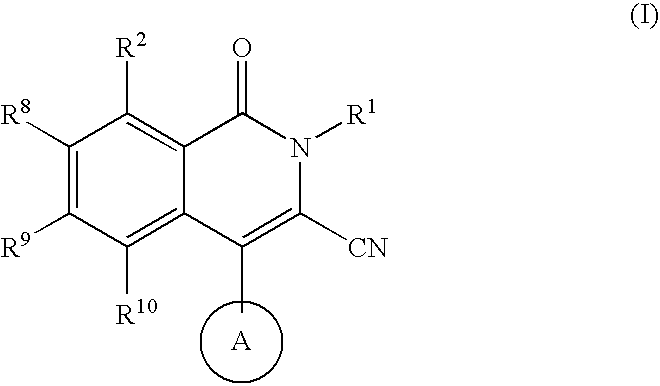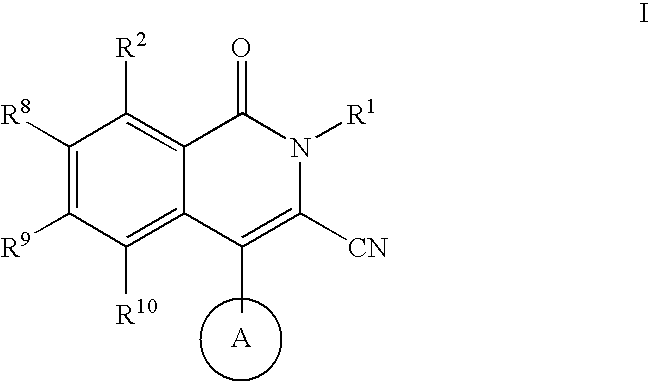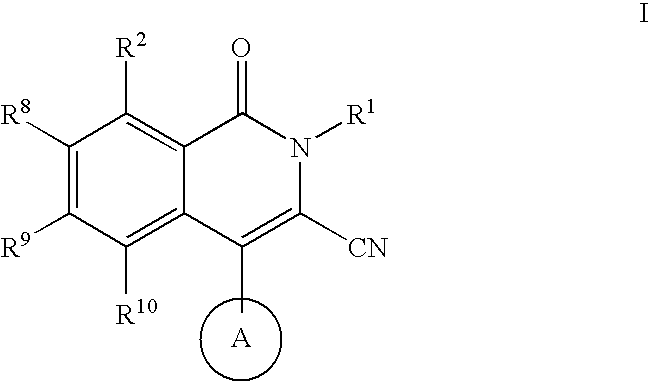Isoquinoline potassium channel inhibitors
a potassium channel inhibitor and isoquinoline technology, applied in the field of compounds, can solve the problems of insufficient selectiveness of ksup>+/sup> channel blockers employed in these early studies, unclear physiologic role of particular channels, and limited therapeutic utility of this compound, so as to prevent cardiac arrhythmias and treat them
- Summary
- Abstract
- Description
- Claims
- Application Information
AI Technical Summary
Benefits of technology
Problems solved by technology
Method used
Image
Examples
example i
Preparation of 2-(2-Amino-(5,6,7,8-tetrahydro-1-naphthyl)ethyl)-3-cyano-6-methoxy-4-phenyl-2H-isoquinolin-1-one (8)
Step A: 4-Methoxy-N-phenyl-benzamide (1)
[0519] p-Anisoyl chloride (10 g, 58.5 mmol) was dissolved in methylene chloride (500 mL) under argon. Aniline (8.0 mL, 87.7 mmol) was added dropwise with stirring. Diisopropylethylamine (10.0 mL, 58.5 mmol) was added dropwise to give a white suspension. After 3 h the contents of the reaction flask were washed with 5% potassium bisulfate then sat. sodium bicarbonate. The organic portion was dried with sodium sulfate (anh.), filtered and evaporated in vacuo to give a solid. Trituration with ethyl acetate gave the title compound 1 as a white solid (3.37 g, 25%)
[0520]1HNMR (CHCl3, 300 MHz) δ 7.88-7.82 (m, 2H); 7.74 (s, br, 1H); 7.66-7.60 (m, 2H); 7.42-7.34 (m, 2H), 7.18-7.10 (m, 1H); 7.02-6.94 (m, 2H); 3.88 (s, 3H).
Step B: 3-Hydroxy-5-methoxy-2,3-diphenyl-2,3-dihydro-isoindol-1-one (2)
[0521] While cooling in a dry ice / isopropan...
example ii
Preparation of 3-Cyano-2-(2-hydroxyethyl)-6-methoxy-4-phenyl-2H-isoquinolin-1-one (47)
[0536] A solution of 7 (250 mg, 0.786 mmol), and sodium triacetoxyborohydride (333 mg, 1.57 mmol) in methylene chloride (10 mL) was stirred for 24 h at room temperature. Saturated sodium bicarbonate was added and the mixture was extracted with methylene chloride (3×). The combined organic extracts were dried with magnesium sulfate (anh.) and filtered. The filtrate was concentrated in vacuo to give 47 as a white solid.
[0537]1HNMR (CHCl3, 300 MHz) δ 8.46 (d, 1H); 7.55 (m, 3H); 7.42 (m, 2H); 7.23 (dd, 1H), 6.67 (d, 1H); 4.55 (m, 2H); 4.10 (m, 2H); 3.76 (s, 3H); 2.55 (m, 1H).
example iii
Preparation of 2-2-Chloroethyl)-3-cyano-6-methoxy-4-phenyl-2H-isoquinolin-1-one (48)
[0538] To a solution of 47 (217 mg, 0.679 mmol), and diisopropylethylamine (0.153 mL, 0.883 mmol) in methylene chloride (2 mL) under nitrogen was added methanesulfonyl chloride (0.068 mL, 0.883 mmol). After 3 h saturated sodium bicarbonate was added and the mixture was extracted with methylene chloride (3×). The combined organic extracts were dried with magnesium sulfate (anh.) and filtered. The filtrate was concentrated in vacuo to give a colorless oil which was subjected to flash column chromatography (ethyl acetate / hexane) to give 48 as a light solid.
[0539]1HNMR (CHCl3, 300 MHz) δ 8.46 (d, 1H); 7.56 (m, 3H); 7.43 (m, 2H); 7.22 (dd, 1H), 4.65 (t, 2H); 3.96 (t, 2H); 3.75 (s, 3H).
PUM
| Property | Measurement | Unit |
|---|---|---|
| Pharmaceutically acceptable | aaaaa | aaaaa |
Abstract
Description
Claims
Application Information
 Login to View More
Login to View More - R&D
- Intellectual Property
- Life Sciences
- Materials
- Tech Scout
- Unparalleled Data Quality
- Higher Quality Content
- 60% Fewer Hallucinations
Browse by: Latest US Patents, China's latest patents, Technical Efficacy Thesaurus, Application Domain, Technology Topic, Popular Technical Reports.
© 2025 PatSnap. All rights reserved.Legal|Privacy policy|Modern Slavery Act Transparency Statement|Sitemap|About US| Contact US: help@patsnap.com



